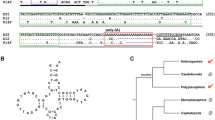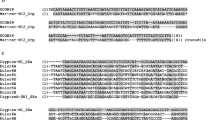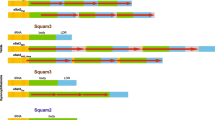Abstract
Ninety-nine members of the salmonid HpaI and AvaIII families of short interspersed repetitive elements (SINEs) were aligned and a general consensus sequence was deduced. The presence of 26 correlated changes in nucleotides (diagnostic nucleotides) from those in the consensus sequence allowed us to divide the members of the HpaI family into 12 subfamilies and those of the AvaIII family into two subfamilies. On the basis of the average sequence divergences and the phylogenetic distributions of the subfamilies, the relative antiquity of the subfamilies and the process of sequential changes in the respective source sequences were inferred. Despite the higher mutation rates of CG dinucleotides in individual dispersed members, no hypermutability of CG positions was observed in changes in the source sequences. This result suggests that sequences of SINEs located in a nonmethylated or hypomethylated genomic region could have been selected as source sequences for retroposition and/or that some CG sites are the parts of recognition sequences of retropositional machineries.
Similar content being viewed by others
References
Antequera F, Bird AP (1988) Unmethylated CpG islands associated with genes in higher plant DNA. EMBO J 7:2295–2299
Batzer MA, Kilroy GE, Richard PE, Shaikh TH, Desselle TD, Hoppens CL, Deininger PL (1990) Structure and variability of recently inserted Alu family members. Nucleic Acids Res 18:6793–6798
Bird AP (1980) DNA methylation and the frequency of CpG in animal DNA. Nucleic Acids Res 8:1499–1504
Bird AP (1987) CpG islands as gene markers in the vertebrate nucleus. Trends Genet 3:342–347
Coltman DW, Wright JM (1994) Can SINEs: a family of tRNA-derived retroposons specific to the superfamily canoidea. Nucleic Acids Res 22:2720–2730
Deininger PL (1989) SINEs: Short interspersed repeated DNA elements in higher eucaryotes. In: Howe M, Berg D (eds) Mobile DNA. ASM Press, Washington DC, pp 619–636
Deininger PL, Batzer MA (1993) Evolution of retroposons. In: Hecht MK et al. (eds) Evolutionary biology, volume 27. Plenum Press, New York, p 157
Deininger PL, Slagel VK (1988) Recently amplified Alu family members share a common parental Alu sequence. Mol Cell Biol 8:4566–4569
Deragon JM, Landry BS, Pélissier T, Tutois S, Tourmente S, Picard G (1994) An analysis of retroposition in plants based on a family of SINEs from Brassica napus. J Mol Evol 39:378–386
Endoh H, Nagahashi S, Okada N (1990) A highly repetitive and transcribable sequence in the tortoise genome is probably a retroposon. Eur J Biochem 189:25–31
Endoh H, Okada N (1986) Total DNA transcription in vitro: a procedure to detect highly repetitive and transcribable sequences with tRNA-like structures. Proc Natl Acad Sci USA 83:251–255
Higgins DG, Bleasby AJ, Fuchs R (1992) CLUSTAL V: improved software for multiple sequence alignment. Comput Appl Biosci 8:189–191
Jagadeeswaran P, Forget BG, Weissman SM (1981) Short interspersed repetitive DNA elements in eucaryotes: transposable DNA elements generated by reverse transcription of RNA pol III transcripts? Cell 26:141–142
Jurka J, Zietkiewicz E, Labuda D (1995) Ubiquitous mammalian-wide interspersed repeats (MIRs) are molecular fossils from the mesozoic era. Nucleic Acids Res 23:170–175
Kass DH, Batzer MA, Deininger PL (1995) Gene conversion as a secondary mechanism of short interspersed element (SINE) evolution. Mol Cell Biol 15:19–25
Kido Y, Aono M, Yamaki T, Matsumoto K, Murata S, Saneyoshi M, Okada N (1991) Shaping and reshaping of salmonid genomes by amplification of tRNA-derived retroposons during evolution. Proc Natl Acad Sci USA 88:2326–2330
Kido Y, Himberg M, Takasaki N, Okada N (1994) Amplification of distinct subfamilies of short interspersed elements during evolution of the Salmonidae. J Mol Biol 241:633–644
Koishi R, Okada N (1991) Distribution of the salmonid Hpal family in the salmonid species demonstrated by in vitro runoff transcription assay of total genomic DNA: a procedure to estimate repetitive frequency and sequence divergence of a certain repetitive family with a few known sequences. J Mol Evol 32:43–52
Labuda D, Sinnett D, Richer C, Deragon J-M, Striker G (1991) Evolution of mouse B1 repeats: 7SL RNA folding pattern conserved. J Mol Evol 32:405–414
Labuda D, Striker G (1989) Sequence conservation in Alu evolution. Nucleic Acids Res. 17:2477–2491
Liu W-M, Schmid CW (1993) Proposed roles for DNA methylation in Alu transcriptional repression and mutational inactivation. Nucleic Acids Res 21:1351–1359
Matera AG, Hellmann U, Hintz MF, Schmid CW (1990) Recently transposed Alu repeats result from multiple source genes. Nucleic Acids Res 18:6019–6023
Mochizuki K, Umeda M, Ohtsubo H, Ohtsubo E (1992) Characterization of a plant SINE, p-SININEl, in rice genome. Jpn J Genet 67:155–166
Murata S, Takasaki N, Saitoh M, Okada N (1993) Determination of the phylogenetic relationships among Pacific salmonids by using short interspersed elements (SINEs) as temporal landmarks of evolution. Proc Natl Acad Sci USA 90:6995–6999
Nisson PE, Hickey RJ, Boshar MF, Crain WR Jr (1988) Identification of a repeated sequence in the genome of the sea urchin which is transcribed by RNA polymerase III and contains the features of a retroposon. Nucleic Acids Res 16:1431–1452
Ohshima K, Koishi R, Matsuo M, Okada N (1993) Several short interspersed repetitive elements (SINEs) in distant species may have originated from a common ancestral retrovirus: characterization of a squid SINE and a possible mechanism for generation of tRNA-derived retroposons. Proc Natl Acad Sci USA 90:6260–6264
Ohshima K, Okada N (1994) Generality of the tRNA origin of short interspersed repetitive elements (SINEs); characterization of three different tRNA-derived retroposons in the octopus. J Mol Biol 243:25–37
Okada N (1991a) SINEs, Cuff Opin Genet Dev 1:498–504
Okada N (1991b) SINEs: short interspersed repeated elements of the eukaryotic genome. Trends Ecol Evol 6:358–361
Rogers J (1983) Retroposons defined. Nature 301:460
Rogers JH (1985) The origin and evolution of retroposons. Int Rev Cytol 93:187–279
Sakagami M, Ohshima K, Mukoyama H, Yasue H, Okada N (1994) A novel tRNA species as an origin of short interspersed repetitive elements (SINEs); equine SINEs may have originated from tRNAser. J Mol Biol 239:731–735
Sambrook J, Fritsch EF, Maniatis T (1989) Molecular cloning: a laboratory manual, 2nd ed. Cold Spring Harbor Laboratory Press, New York
Schmid C, Maraia R (1992) Transcriptional regulation and transpositional selection of active SINE sequences. Curr Opin Genet Dev 2:874–882
Singer MF (1982) SINEs and LINEs: highly repeated short and long interspersed sequences in mammalian genomes. Cell 28:433–434
Smit AFA, Riggs AD (1995) MIRs are classic, tRNA-derived SINEs that amplified before the mammalian radiation. Nucleic Acids Res 23:98–102
Spotila LD, Hirai H, Rekosh DM, LoVerde PT (1989) A retroposon-like short repetitive DNA element in the genome of the human blood fluke, Schistosoma mansoni. Chromosoma 97:421–428
Takasaki N, Murata S, Saitoh M, Kobayashi T, Park L, Okada N (1994) Species-specific amplification of tRNA-derived short interspersed elements (SINEs) by retroposition: a process of parasitization of entire genomes during the evolution of salmonids. Proc Natl Acad Sci USA 91:10153–10157
Van Arsdell SW, Denison RA, Bernstein LB, Weiner AM, Manser T, Gesteland RF (1981) Direct repeats flank three small nuclear RNA pseudogenes in the human genome. Cell 26:11–17
Weiner AM, Deininger PL, Efstratiadis A (1986) Nonviral retroposons: genes, pseudogenes, and transposable elements generated by the reverse flow of genetic information. Annu Rev Biochem 55:631–661
Yoshioka Y, Matsumoto S, Kojima S, Ohshima K, Okada N, Machida Y (1993) Molecular characterization of a short interspersed repetitive element from tobacco that exhibits sequence homology to specific tRNAs. Proc Natl Acad Sci USA 90:6562–6566
Author information
Authors and Affiliations
Additional information
Correspondence to: N. Okada
Rights and permissions
About this article
Cite this article
Kido, Y., Saitoh, M., Murata, S. et al. Evolution of the active sequences of the HpaI short interspersed elements. J Mol Evol 41, 986–995 (1995). https://doi.org/10.1007/BF00173180
Received:
Accepted:
Issue Date:
DOI: https://doi.org/10.1007/BF00173180




